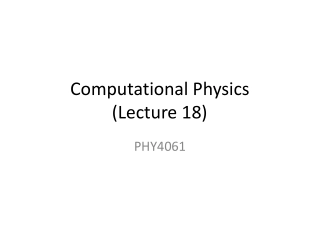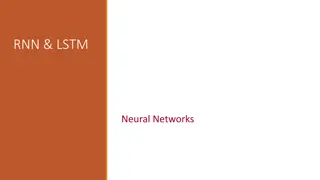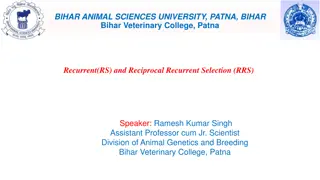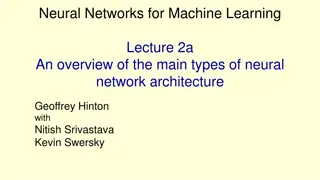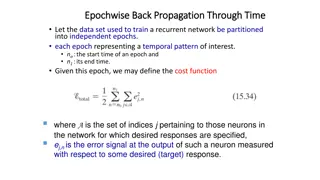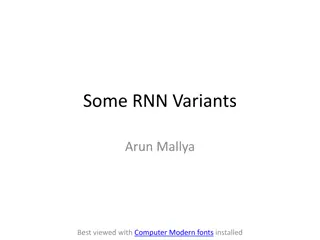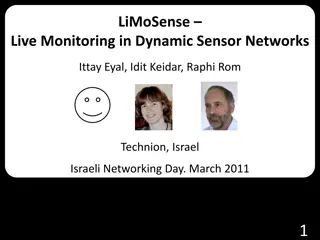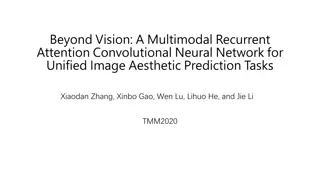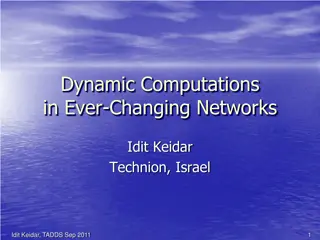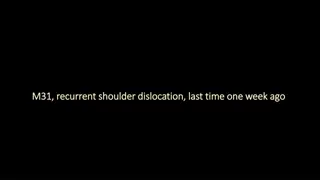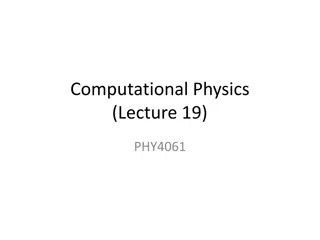Understanding Dynamic Recurrent Networks
Dynamic networks operate on a sequence of inputs with memory, allowing them to learn time-varying patterns and approximate dynamic systems. This has applications in various fields such as control systems, finance, communication, and genetics. Recurrent networks offer a rich variety of architectural layouts, making them powerful in computational tasks.
Download Presentation

Please find below an Image/Link to download the presentation.
The content on the website is provided AS IS for your information and personal use only. It may not be sold, licensed, or shared on other websites without obtaining consent from the author.If you encounter any issues during the download, it is possible that the publisher has removed the file from their server.
You are allowed to download the files provided on this website for personal or commercial use, subject to the condition that they are used lawfully. All files are the property of their respective owners.
The content on the website is provided AS IS for your information and personal use only. It may not be sold, licensed, or shared on other websites without obtaining consent from the author.
E N D
Presentation Transcript
Dynamically Driven Recurrent Networks Dynamically Driven Recurrent Networks
Introduction Dynamic networks are networks that contain delays (or integrators, for continuous-time networks) and that operate on a sequence of inputs. In other words, the ordering of the inputs is important to the operation of the network. These dynamic networks can have purely feedforward connections, like adaptive filters, or they can also have some feedback (recurrent) connections, like the Hopfield network. Dynamic networks have memory. Their response at any given time will depend not only on the current input, but on the history of the input sequence.
Because dynamic networks have memory, they can be trained to learn sequential or time-varying patterns. Instead of approximating functions, like the static multilayer perceptron network, a dynamic network can approximate a dynamic system. This has applications in such diverse areas as: control of dynamic systems prediction in financial markets channel equalization in communication systems phase detection in power systems sorting, fault detection speech recognition learning of grammars in natural languages prediction of protein structure in genetics.
Consider, for example, a multilayer perceptron with a single hidden layer as the basic building block of a recurrent network. The application of global feedback around the multilayer perceptron can take a variety of forms. We may apply feedback from the outputs of the hidden layer of the multilayer perceptron to the input layer. Alternatively, we may apply the feedback from the output layer to the input of the hidden layer. We may even go one step further and combine all these possible feedback loops in a single recurrent network structure. We may also, of course, consider other neural network configurations as the building blocks for the construction of recurrent networks
The important point is that recurrent networks have a very rich repertoire of architectural layouts, which makes them all the more powerful in computational terms. By definition, the input space of a mapping network is mapped onto an output space. For this kind of application, a recurrent network responds temporally to an externally applied input signal. We may therefore considered recurrent networks here as dynamically driven recurrent networks.
2 2. . RECURRENT NETWORK ARCHITECTURES RECURRENT NETWORK ARCHITECTURES As mentioned in the introduction, the architectural layout of a recurrent network takes many different forms. In this section, we describe four specific network architectures, each of which highlights a specific form of global feedback.
Input Input Output Recurrent Model Output Recurrent Model1 1 Figure 15.1 shows the architecture of a generic recurrent network that follows naturally from a multilayer perceptron. The model has a single input that is applied to a tapped delay-line memory of q units. It has a single output that is fed back to the input via another tapped-delay- line memory, also of q units. The contents of these two tapped- delay-line memories are used to feed the input layer of the multilayer perceptron.
Input Input Output Recurrent Model Output Recurrent Model2 2 FIGURE 15.1 Nonlinear autoregressive with exogenous inputs (NARX) model; the feedback part of the network is shown in blue.
NARX network NARX network
Dynamic behavior of NARX Dynamic behavior of NARX
Un : present input value yn+1 : corresponding value of the output that is, the output is ahead of the input by one time unit. Thus, the signal vector applied to the input layer of the multilayer perceptron consists of a data window made up of the following components un, un-1, ..., un-q+1 : present and past values of the input, which represent exogenous inputs originating from outside the network yn, yn-1, ..., yn-q+1 : delayed values of the output
The recurrent network of Fig. 15.1 is referred to as a nonlinear autoregressive with exogenous inputs (NARX) model. The dynamic behavior of the NARX model is yn+1= F(yn, ...., yn-q+1; un, ...., un-q+1) (15.1) where F is a nonlinear function of its arguments. Note that in Fig. 15.1 we have assumed that the two delay-line memories in the model are both of size q; they are generally different, however.
State State- -Space Model Space Model (Second generic recurrent network) (Second generic recurrent network) The output of the hidden layer is fed back to the input layer via a bank of unit-time delays. The input layer consists of a concatenation of feedback nodes and source nodes. FIGURE 15.2 State-space model; the feedback part of the model is shown in blue.
State State- -Space Model Space Model2 2 The hidden neurons define the state of the network. The network is connected to the external environment via the source nodes. The number of unit-time delays used to feed the output of the hidden layer back to the input layer determines the order of the model. Let the m-by-1 vector undenote the input vector and the q-by-1 vector xndenote the output of the hidden layer at time n. The dynamic behavior of the model may described by the following pair of equations: xn +1= a(xn , un) (15.2) yn= Bxn (15.3) where a( , ) is a nonlinear function characterizing the hidden layer and B is the matrix of synaptic weights characterizing the output layer. The hidden layer is nonlinear, but the output layer is linear.
State State- -Space Model Space Model Special Cases The recurrent network of Fig. 15.2 includes several recurrent architectures as special cases. For example, the simple recurrent network (SRN) described in Elman (1990, 1996), and depicted in Fig. 15.3. Special Cases FIGURE 15.3 Simple recurrent network (SRN)
Fig. 15.3, has an architecture similar to that of Fig. 15.2, except for the fact that: the output layer may be nonlinear and the bank of unit-time delays at the output is omitted. It is commonly referred to in the literature as a simple recurrent network (SRN) in the sense that the error derivatives computed by the recurrent network are simply delayed by one time-step back into the past; however, this simplification does not prevent the network from storing information from the distant past.
Recurrent Multilayer Perceptrons Recurrent Multilayer Perceptrons1 1 (Third Model) The third recurrent architecture considered here is known as a recurrent multilayer perceptron (RMLP). It has one or more hidden layers. Each computation layer of an RMLP has feedback around it, as illustrated for the case of an RMLP with two hidden layers. (Third Model)
xI,n : output of the first hidden layer, xII,n : output of the second hidden layer, and so on. xo,n: the ultimate output of the output layer. Then the general dynamic behavior of RMLP in response to an input vector un is :
Recurrent Multilayer Perceptrons Recurrent Multilayer Perceptrons3 3 where I( , ), II( , ) , ..., o( , ) denote the activation functions characterizing the first hidden layer, second hidden layer and output layer of the RMLP, respectively, and K denotes the number of hidden layers in the network; (in the above network, K = 2).
Second Second- -Order Network Order Network1 1 (Fourth Model) (Fourth Model) In describing the state-space model, we used the term order to refer to the number of hidden neurons whose outputs are fed back to the input layer via a bank of time- unit delays. In yet another context, the term order is sometimes used to refer to the way in which the induced local field of a neuron is defined. Consider, For example, a multilayer perceptron where the induced local field vkof neuron k is defined by
Second Second- -Order Network Order Network2 2 xj : feedback signal derived from hidden neuron j , ui : source signal applied to node i in the input layer; and. w s : synaptic weights in the network. We refer to a neuron described in Eq. (15.5) as a first-order neuron. When, however, the induced local field vk is combined using multiplications, as shown by we refer to the neuron as a second-order neuron. The second-order neuron k uses a single weight wkijthat connects it to the input nodes i and j.
Second-order recurrent network; bias connections to the neurons are omitted for simplicity The network has 2 inputs and 3 state neurons, hence the need for 3 * 2 = 6 multipliers.


